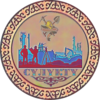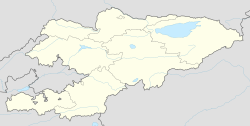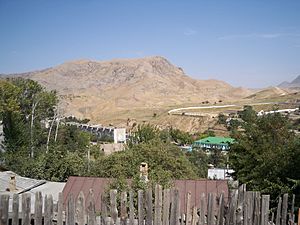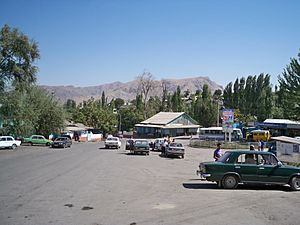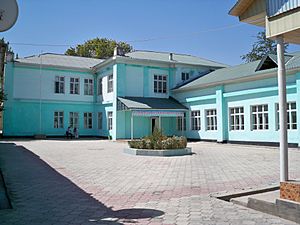Sülüktü facts for kids
Quick facts for kids
Sülüktü
Сүлүктү
Sulukta
|
||
|---|---|---|
|
Town
|
||
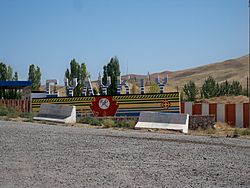
The sign in the western corner of Sülüktü
|
||
|
||
| Country | ||
| Region | Batken | |
| Founded | 1868 | |
| City status | 1940 | |
| Area | ||
| • Total | 18 km2 (7 sq mi) | |
| Elevation | 1,380 m (4,530 ft) | |
| Population
(2021)
|
||
| • Total | 24,238 | |
| • Density | 1,350/km2 (3,490/sq mi) | |
| Time zone | UTC+6 | |
| Postal code |
720500
|
|
| Area code(s) | +996 3653 | |
Sülüktü (also spelled Sulukta) is a town in southern Kyrgyzstan. It is located in the Batken Region, very close to the border with Tajikistan. The town sits at the edge of the Fergana Valley.
The name "Sülüktü" might come from an old Turkic word meaning "leech". This suggests that the waters in the area once had many leeches. Sülüktü is famous for being one of the oldest places in Central Asia where coal was dug up. The first big coal mine started here in 1868. Sülüktü officially became a town in 1940. It was also the first town in Kyrgyzstan where the Soviet government took control.
Sülüktü is directly managed by the Batken Region. This means it is not part of a smaller district. The nearby town of Vostochny and the village of Koltso are also part of the Sülüktü Town Council. In 2021, about 14,770 people lived in Sülüktü itself. Including the nearby villages, the total population was 24,238. The town covers an area of 18 square kilometers.
During the time of the Soviet Union, Sülüktü had many large coal mines and factories. After the Soviet Union broke apart, most of these factories closed down. This happened because there weren't enough skilled workers, machines got old, and money became scarce. Sülüktü was once a very important industrial town, but it has changed a lot since then.
Contents
History of Sülüktü
Sülüktü has a long history of coal mining. It is one of the oldest places in Central Asia where coal has been dug up. The first industrial coal mine opened in 1868. Sülüktü became a town in 1940. It was also the first town in Kyrgyzstan to come under Soviet rule.
During the Soviet era, Sülüktü was a key industrial town. It had several large coal mines. Besides coal, people also dug up gypsum, quartz sand, and limestone. The town also had factories that processed meat, made cream, produced bricks, and created clothing.
After the Soviet Union ended, many people who were not Kyrgyz left Sülüktü. These included many experienced workers. In the 1990s, almost all the factories in Sülüktü closed. This was due to a lack of skilled workers, broken trade routes, old machines, and poor management.
Geography and Climate
Sülüktü is located in the western part of the Batken Region. It sits at an altitude of 1,380 meters (about 4,528 feet) above sea level. The town is just north of the Turkestan Range mountains. The area around Sülüktü has many hills and low mountains.
Sülüktü's Climate
Sülüktü has a cold desert climate. This means it has very cold winters and hot, dry summers. The winter season is not very long. Spring and fall get some rain, but the summers are usually hot and dry. The climate in Sülüktü is similar to the nearby town of Isfana. However, Sülüktü gets less rain than Isfana.
| Climate data for Sülüktü | |||||||||||||
|---|---|---|---|---|---|---|---|---|---|---|---|---|---|
| Month | Jan | Feb | Mar | Apr | May | Jun | Jul | Aug | Sep | Oct | Nov | Dec | Year |
| Mean daily maximum °C (°F) | 4 (39) |
6 (43) |
13 (55) |
22 (72) |
28 (82) |
34 (93) |
36 (97) |
33 (91) |
29 (84) |
20 (68) |
15 (59) |
5 (41) |
20 (69) |
| Mean daily minimum °C (°F) | −2 (28) |
−1 (30) |
4 (39) |
11 (52) |
15 (59) |
20 (68) |
21 (70) |
19 (66) |
14 (57) |
8 (46) |
4 (39) |
0 (32) |
9 (49) |
| Average precipitation mm (inches) | 18 (0.7) |
24 (0.9) |
24 (0.9) |
24 (0.9) |
18 (0.7) |
9 (0.4) |
3 (0.1) |
6 (0.2) |
3 (0.1) |
27 (1.1) |
15 (0.6) |
30 (1.2) |
201 (7.8) |
People and Population
How Many People Live Here?
| Historical population | ||
|---|---|---|
| Year | Pop. | ±% p.a. |
| 1970 | 18,483 | — |
| 1979 | 19,030 | +0.32% |
| 1989 | 22,159 | +1.53% |
| 1999 | 21,219 | −0.43% |
| 2009 | 20,725 | −0.24% |
| 2021 | 24,238 | +1.31% |
| Note: resident population; Sources: | ||
Many different groups of people live in Sülüktü. The largest group is the Kyrgyz. According to a 2009 study, the people living in Sülüktü and its nearby villages were:
Most people in Sülüktü follow the Muslim faith. They are Sunni Muslims. The town has 15 mosques and one Orthodox church.
Here is a look at the population in 2021 for Sülüktü and its nearby areas:
| Settlement | Population |
|---|---|
| Sülüktü | 14,770 |
| Vostochny | 8,611 |
| Koltso | 712 |
Economy and Work
Many people from Sülüktü work in other countries, especially Russia. They also go to nearby Kazakhstan and Tajikistan to find jobs. We don't have exact numbers for how many people leave Sülüktü to work.
Those who stay in town often work in trade. Sülüktü does not have one very big market. Instead, it has several smaller markets. Sellers in Sülüktü bring their goods from larger markets in cities like Osh, Kara-Suu, and Khujand.
The economy in Sülüktü is mostly based on small shops and kiosks. A lot of buying and selling happens at these small markets and kiosks all over town. Much of this trade is not officially regulated.
Coal Mining in Sülüktü
Sülüktü is one of the oldest places for coal mining in Central Asia. People have been digging for coal here since the 10th or 11th century. Scientists first studied the coal in Sülüktü in 1903. They found that the coal deposits are very old, from the Paleozoic, Mesozoic, and Cenozoic eras.
The layers of coal in Sülüktü can be from 35 to 120 meters thick. In some places, there are valuable coal layers 600–750 meters deep. The main coal layer is 0.1–18 meters thick and stretches for about 22 kilometers.
The coal found in Sülüktü is mostly lignite, which is also called brown coal. In the past, coal was dug up both from the surface and from underground mines. Now, it is only dug up from underground. Most of the large government-owned mines from the Soviet time have been replaced by smaller private mines.
Education in Sülüktü
Schools for Kids
Sülüktü has many places for learning. There are nine secondary schools in the town. One of them is a special school called a lyceum, and another is a gymnasium school. Students in Sülüktü learn in Kyrgyz, Uzbek, and Russian. All students must learn Kyrgyz and Russian, which are the official languages of Kyrgyzstan. English is also taught in all schools, but the teaching quality can vary. This means Uzbek students in Sülüktü learn four languages, and Kyrgyz students learn three.
Colleges and Universities
Sülüktü has three places for higher education. The biggest one is the Sülüktü Institute of Humanities and Economics (SIHE). This institute is part of the Batken State University (BSU). Sülüktü also has the Sülüktü Engineering and Economics School and the Sülüktü Pedagogical College. Both of these are also branches of the BSU.
There is also Vocational School No. 73 in Sülüktü. This school teaches students skills like being a seamstress, a carpenter, an electrician, or a driver.
Culture and Fun
Sülüktü has two libraries: a general library and a children's library. Both are open to everyone. The children's library has two buildings, one in Sülüktü and one in Vostochny. The general library has over 55,000 books and other items, while the children's library has over 88,000 items.
The town also has a children's music school, which opened in 1936. At this school, children can learn to sing, dance, and play different musical instruments. There is also a branch of the music school in Vostochny.
Sülüktü has one park. Near the park is a soccer stadium that can hold up to 5,000 people. The town also has a recreation center, which was built in 1932.
About 35 kilometers from Sülüktü, in the mountains, there is a summer camp called "The Mountain Eagle." This camp opened in 1965 and was updated in 2004. It can host up to 500 children at a time.
Getting Around
In the past, during Soviet times, there was a narrow gauge railway that connected Sülüktü to the city of Khojand in Tajikistan. This train line was closed after Kyrgyzstan became an independent country.
Sülüktü does not have an airport. The closest airport is in the nearby town of Isfana, which is 16 kilometers away. Roads connect Sülüktü to other towns and villages in the Leylek District. The capital city, Bishkek, is about 950 kilometers away from Sülüktü.
See also
 In Spanish: Suliukta para niños
In Spanish: Suliukta para niños


